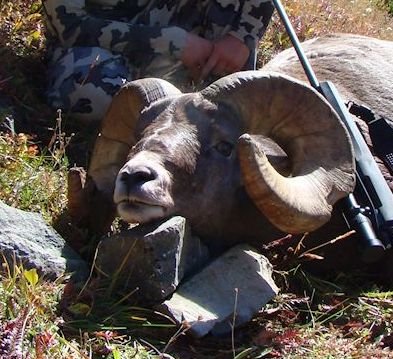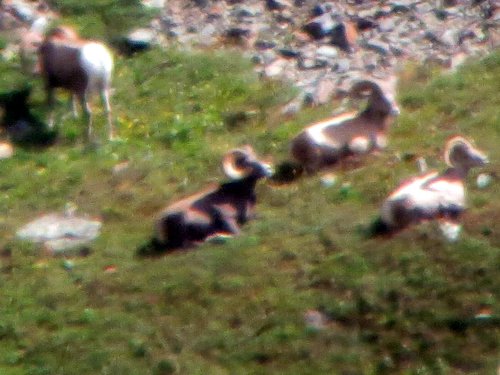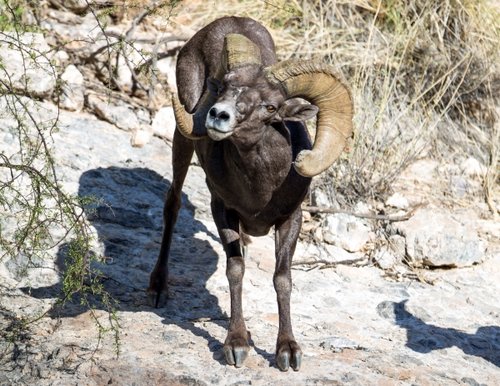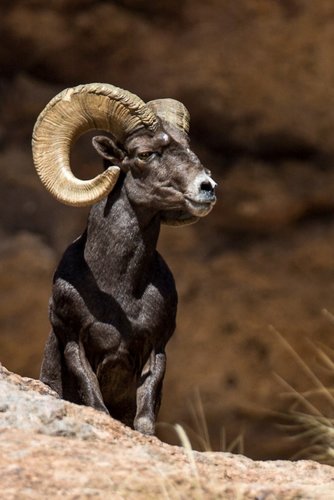Scoring sheep on the hoof is tough, and you really need to know what the area typically produces for base circumferences. That said, it's not always about the score. Example: one of the rams below makes the all-time B&C list. The other misses by over 10". I'm sure you can guess which is which.
Navigation
Install the app
How to install the app on iOS
Follow along with the video below to see how to install our site as a web app on your home screen.
Note: This feature may not be available in some browsers.
More options
You are using an out of date browser. It may not display this or other websites correctly.
You should upgrade or use an alternative browser.
You should upgrade or use an alternative browser.
Score Guess
- Thread starter ----
- Start date
Scoring sheep on the hoof is tough, and you really need to know what the area typically produces for base circumferences. That said, it's not always about the score. Example: one of the rams below makes the all-time B&C list. The other misses by over 10". I'm sure you can guess which is which.
Left ram scores higher.
Left ram scores higher.
Of course. His bases are almost 3 inches bigger. He is only 5 years old. But the right ram is more mature and has a lot of cool factor.
The Hedgehog
Well-known member
- Joined
- Dec 19, 2000
- Messages
- 11,612
I'm a sheep dunce, but I'd say the left could be a booner, and I'd still pass. 6year old ram from the breaks?
The Hedgehog
Well-known member
- Joined
- Dec 19, 2000
- Messages
- 11,612
Of course. His bases are almost 3 inches bigger. He is only 5 years old. But the right ram is more mature and has a lot of cool factor.
Isn't the first dark ring his 3 year line? somebody told met that recently when I was asking how to judge them.
Isn't the first dark ring his 3 year line? somebody told met that recently when I was asking how to judge them.
He might be 6. Hunter and CPW both said 5. He is listed in B&C at 180 1/8" net. Both are CO rams.
Of course. His bases are almost 3 inches bigger. He is only 5 years old. But the right ram is more mature and has a lot of cool factor.
Ha, I'm horrible at this. I thought it was a trick question and I was going out on a limb. I'd rather go after the older ram.
elk_hunter
Active member
No way, I am horrible. Oak, how do you even begin to judge based on those photos? I would have thought the ram on the right would score more...seriously. How do you know how big the bases are from the pics? How do you estimate the length - use ears?
Lv2hnt
Well-known member
Always makes it tough to compare rams when you're looking at them from different angles --- mass starting from bases carried through to ends, how wide/tight the horns curl around (how far back behind the ear?), how far the horns come to the lower jawline/overall horn length --- it all adds up. I only have experience looking at deserts (smaller bodies), 'tho the principles are the same.
As already mentioned, sometimes a ram's score takes a back seat to the "It" factor. This ram my friend ended up shooting earlier this month was several inches smaller than some larger rams in the unit he hunted. The ram's battered noggin was the clincher for my buddy ...
As already mentioned, sometimes a ram's score takes a back seat to the "It" factor. This ram my friend ended up shooting earlier this month was several inches smaller than some larger rams in the unit he hunted. The ram's battered noggin was the clincher for my buddy ...
Attachments
No way, I am horrible. Oak, how do you even begin to judge based on those photos? I would have thought the ram on the right would score more...seriously. How do you know how big the bases are from the pics? How do you estimate the length - use ears?
I'm horrible, too. I had the benefit of the hunters that killed them telling me the measurements.
For some really good information about scoring Rockys, check out this article that Bighorn191 contributed to in Western Hunter a few years ago. Apologies to Big Fin if I shouldn't post the link, and feel free to delete.
Field Judging Rocky Mountain Bighorn Sheep
T Bone
Well-known member
I'd love to smoke a mid 160's ram in Idaho. Owyhee style.
dan.kirkpatrick
Well-known member
good looking ram,,id guess in the 170s,,mass carrys well.
shoots-straight
Well-known member
I'm going with 165 to 170
I'd love to smoke a mid 160's ram in Idaho. Owyhee style.
Me too, hopefully next year
BIGHORNtracks
New member
- Joined
- Nov 4, 2014
- Messages
- 9
Green horn, you asked if the first "dark ring" is the 3 year ring.
I am going to try and help you out with this.
I am no expert, but I am a fanatical BIGHORN sheep photographer.
I spend a ton of time out in sheep country. I have even been asked to help out on a couple sheep hunts.
In my experience, the three year ring is always hard to see.
Example, see this photo. There is, what I would assume to be a three year ring, just above the busted section of this rams right horn.
If you compare its visibility to the visibility of the other growth rings, you can see that it does not have the same hardness to it.
From distance, the three year ring can be tough to see. Also, especially on older rams, the three year ring can be totally broomed off.
Through my spotter, unless I have a good view, I default to assuming that the first ring I can see is likely the four year ring.

Another good rings image.

That being said.
You really have to spend some time with sheep to get an understanding of rings.
I don't actually believe that you can always go off of rings.
Ever heard of "rut rings" or have you ever seen a sheep that appeared to have lots and lot of rings?
They sometimes only space a half inch apart.
I have also seen rams that appear to have almost no growth rings. Its not common, but sometimes the rings are so faint, that seeing them from ay kind of distance seems impossible.
So how would you "age" those sheep when you can see a mature ram, but only see say one or two rings?

Sorry, I don't want to make it harder for you.
Like I said, I am no expert. Just a fanatic.
Growth rings are the best guessing tool we have.
But they are not always accurate.
Genetics, seasonal conditions, food and water all play a role in your areas sheep herd.
They all play a part in horn growth as well.
It is possible that in your area, the three year ring is a hard, dark, very visible ring.
Not typically in my area. The only way for you to know for sure is get out there and look at a lot of sheep.
I am going to try and help you out with this.
I am no expert, but I am a fanatical BIGHORN sheep photographer.
I spend a ton of time out in sheep country. I have even been asked to help out on a couple sheep hunts.
In my experience, the three year ring is always hard to see.
Example, see this photo. There is, what I would assume to be a three year ring, just above the busted section of this rams right horn.
If you compare its visibility to the visibility of the other growth rings, you can see that it does not have the same hardness to it.
From distance, the three year ring can be tough to see. Also, especially on older rams, the three year ring can be totally broomed off.
Through my spotter, unless I have a good view, I default to assuming that the first ring I can see is likely the four year ring.

Another good rings image.

That being said.
You really have to spend some time with sheep to get an understanding of rings.
I don't actually believe that you can always go off of rings.
Ever heard of "rut rings" or have you ever seen a sheep that appeared to have lots and lot of rings?
They sometimes only space a half inch apart.
I have also seen rams that appear to have almost no growth rings. Its not common, but sometimes the rings are so faint, that seeing them from ay kind of distance seems impossible.
So how would you "age" those sheep when you can see a mature ram, but only see say one or two rings?

Sorry, I don't want to make it harder for you.
Like I said, I am no expert. Just a fanatic.
Growth rings are the best guessing tool we have.
But they are not always accurate.
Genetics, seasonal conditions, food and water all play a role in your areas sheep herd.
They all play a part in horn growth as well.
It is possible that in your area, the three year ring is a hard, dark, very visible ring.
Not typically in my area. The only way for you to know for sure is get out there and look at a lot of sheep.
Bambistew
Well-known member
Not sure on score. Nice looking ram, and looks like a 8 or 9yo ram and worthy of a trip home in a backpack, IMO.
Sweet pictures BIGHORNtracks!
Great question. My experience, yes, but some times the second ring can be seen easily as well. The third ring is almost always at the 1/2+/- curl mark. Of course there are exceptions to this, depending on genetics, and any place besides the Breaks. I've read a few studies that suggest that about 75% of rams are full curl (or would be if not broomed) by age 8, another 10-15% before they die, and the rest never make it.
Many older rams will broom to the second growth ring or slightly past. I haven't seen many to the third, that is a lot of horn to break off...
The second ring is usually discernible, but pretty faint, its generally a variation of the growth pattern more so than an actual dark "ring," the fold/growth pattern of the melanin tends to get scrunched, forming a somewhat discernible 2nd ring. The "first" ring or lamb tip nub is usually gone due to brooming or rubbing on mature rams. Usually present on most all rams until 5-7. The lamb tip is typically 2"+/- long, has no ring, and is indiscernible, or may present as a small smooth bump all the way round the horn.
A ring forms when food becomes less abundant and nutritional value drops. Consequently nutrition shifts from horn production, to sustaining life, thus the horns stop growing in the winter and a ring is formed. The glands that produce the horns continue to produce oil, leaving a stain or a ring at the base. This "stain" is visible on the inside of the core as well, not just the outside. This tends to coincide with the rut. I haven't read anything that suggest the rut causes the ring. Note that ewes also have rings that also form in the winter.
I presume "rut ring" is lingo for a false annuli? These are generally rejected as actual growth rings by the incremental growth dimension (each year the horn growth decreases), and also that the inside horn angle change is not present. If you hold the horn just right you can see the change in angle of about 5 degrees at the annuli along the inside of the curl, its not a smooth circle. The outside of the horn tends to be a smooth circle. When the horn starts growing again, the angle of growth shifts slightly.
In the Yukon they take meticulous measurements of all the sheep that are killed. They chart the growth ring dimensions (length and girth) for each year. A recent study I read, stated that out of the thousands of horns they measured, there was only a couple that didn't follow the incremental growth measurement rule. Something happened to the ram and his health suffered, consequently his horn growth grew less than expected. They use this method to rule out false annuli with a high degree of certainty, and also for historical record keeping.
If you really want to see growth rings, section a horn, only true growth rings will appear dark throughout the section of the horn from the outside to the inner core.
False annuli, if present will generally show up every year and follow the same growth pattern as the actual annuli. Meaning if you see a false annuli at the 1/3 mark between rings, it will show up at the same 1/3 mark the following years of life. I'm speculating, but it may be due to change in diet? I don't recall reading anything concrete for reasons for false annuli.
Sweet pictures BIGHORNtracks!
Isn't the first dark ring his 3 year line? somebody told me that recently when I was asking how to judge them.
Great question. My experience, yes, but some times the second ring can be seen easily as well. The third ring is almost always at the 1/2+/- curl mark. Of course there are exceptions to this, depending on genetics, and any place besides the Breaks. I've read a few studies that suggest that about 75% of rams are full curl (or would be if not broomed) by age 8, another 10-15% before they die, and the rest never make it.
Many older rams will broom to the second growth ring or slightly past. I haven't seen many to the third, that is a lot of horn to break off...
The second ring is usually discernible, but pretty faint, its generally a variation of the growth pattern more so than an actual dark "ring," the fold/growth pattern of the melanin tends to get scrunched, forming a somewhat discernible 2nd ring. The "first" ring or lamb tip nub is usually gone due to brooming or rubbing on mature rams. Usually present on most all rams until 5-7. The lamb tip is typically 2"+/- long, has no ring, and is indiscernible, or may present as a small smooth bump all the way round the horn.
A ring forms when food becomes less abundant and nutritional value drops. Consequently nutrition shifts from horn production, to sustaining life, thus the horns stop growing in the winter and a ring is formed. The glands that produce the horns continue to produce oil, leaving a stain or a ring at the base. This "stain" is visible on the inside of the core as well, not just the outside. This tends to coincide with the rut. I haven't read anything that suggest the rut causes the ring. Note that ewes also have rings that also form in the winter.
I presume "rut ring" is lingo for a false annuli? These are generally rejected as actual growth rings by the incremental growth dimension (each year the horn growth decreases), and also that the inside horn angle change is not present. If you hold the horn just right you can see the change in angle of about 5 degrees at the annuli along the inside of the curl, its not a smooth circle. The outside of the horn tends to be a smooth circle. When the horn starts growing again, the angle of growth shifts slightly.
In the Yukon they take meticulous measurements of all the sheep that are killed. They chart the growth ring dimensions (length and girth) for each year. A recent study I read, stated that out of the thousands of horns they measured, there was only a couple that didn't follow the incremental growth measurement rule. Something happened to the ram and his health suffered, consequently his horn growth grew less than expected. They use this method to rule out false annuli with a high degree of certainty, and also for historical record keeping.
If you really want to see growth rings, section a horn, only true growth rings will appear dark throughout the section of the horn from the outside to the inner core.
False annuli, if present will generally show up every year and follow the same growth pattern as the actual annuli. Meaning if you see a false annuli at the 1/3 mark between rings, it will show up at the same 1/3 mark the following years of life. I'm speculating, but it may be due to change in diet? I don't recall reading anything concrete for reasons for false annuli.
Last edited:
Similar threads
- Replies
- 25
- Views
- 2K
- Replies
- 146
- Views
- 9K




![635300504_man_smile[1].jpg](/data/attachments/29/29111-b57900077e7093bd13be14b9b98af962.jpg)




